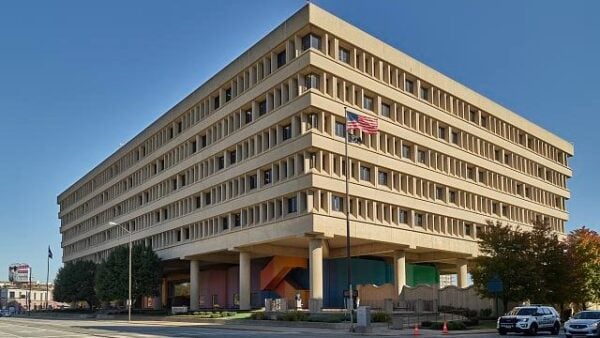Congressman Carson decries move
Three federally owned buildings in Indiana could be at risk after President Donald Trump’s administration announced plans to sell hundreds of properties nationwide as part of federal cost-saving efforts.
The General Services Administration (GSA), which handles the government’s real estate portfolio, announced Tuesday that it is considering selling off hundreds of assets deemed “not core to government operations.”
An initial list included 440 buildings up for “disposal,” which could mean a sale or property transfer. Later Tuesday, the list was scaled back to 320 properties, although Indiana’s three properties remained.
The GSA appeared to remove the list as of Wednesday morning, but the agency said it expects to republish it “in the near future.”
Possibly on the chopping block are the Major General Emmett J. Bean Federal Center in Lawrence, at the heart of the former Fort Benjamin Harrison Military Base; the Minton-Capehart Federal Building in downtown Indianapolis; and the Lee H. Hamilton Federal Building and U.S. Courthouse in New Albany, near the Ohio River.

The federal government owns 10 properties across Indiana, plus another 97 leases for other spaces. The website for Elon Musk’s government overhaul operation, known as the Department of Government Efficiency (DOGE), shows five such leases in the Hoosier State have already terminated.
It’s unclear when — or if — any action will taken to offload the buildings.
“DOGE claims these buildings are functionally obsolete and unsuitable for use by the federal workforce. This is untrue. I serve as a senior member of the House Transportation & Infrastructure Committee, and we publicly reviewed and approved both local facilities to ensure they are in the best condition possible to fulfill their respective agency missions,” Democratic U.S. Rep. André Carson said in a late Wednesday statement.
Carson provided new information on other cuts, too, indicating that DOGE has separately and “arbitrarily terminated contract funding” for a feasibility study necessary to start construction of a new U.S Department of Veteran Affairs (VA) medical facility planned in Indianapolis. Congress previously earmarked $2.3 million to get the project underway.
“The new facility is necessary because the current Roudebush Medical Center is beyond capacity and at the end of its building lifecycle – in other words, we have to build a new facility, or our veterans won’t get the health care they need,” Carson said.
“DOGE’s website is deceptively sparse on details, but big on numbers that don’t add up. It provides no substantive cost-benefit analysis or mission-driven justification for these terrible actions,” he continued. “I am working with my colleagues to do everything possible to stop DOGE’s destruction and reverse these devastating actions – from oversight and investigation, to legislation and litigation, and making sure everyone sees what happens when an unqualified, unelected billionaire hijacks our government. Our veterans and our seniors deserve better.”
Numerous other state and federal elected officials declined or didn’t respond to requests for comment.
“This would be a threat to both the Indianapolis and Indiana economy, and it would certainly, if implemented, affect the ability of hardworking Hoosiers to put food on the tables for their families,” said Gordon Hendry, a former Democrat public official now serving as managing director of the HRE real estate firm in Indianapolis. “It sounds to me like it’s another poorly thought-out proposal coming from DOGE, and it just doesn’t make a lot of sense in the real world.”

Buildings in jeopardy
GSA officials said the agency would decide whether the government should sell off the buildings “in an orderly fashion to ensure taxpayers no longer pay for empty and underutilized federal office space, or the significant maintenance costs associated with long-term building ownership — potentially saving more than $430 million in annual operating costs.”
The announcement advances a major priority for DOGE, which has fixated on eliminating “underutilized” federal office space.
DOGE, which is not an actual department, keeps a running list of savings it claims to have achieved, including lease terminations. Even so, The New York Times has reported the DOGE “wall of receipts” has had to delete some claims that were in error.
At 1.58 million square feet — spanning 72 acres at 56th Street and North Post Road in the northeast Indianapolis area — the Emmett Bean Federal Center is the largest of the buildings on GSA’s disposal list. The complex serves as a hub for numerous federal agencies and departments and thousands of government employees.
Carson said it is the second largest federal building after the Pentagon.
It’s notably the headquarters for the Defense Finance and Accounting Service, which handles payroll for all military and civilian employees, as well as retirees and major defense contractors and vendors. The facility houses 4,000 of the service’s nearly 13,000 employees, according to the GSA.
Hendry, who served as economic development director for former Indianapolis Mayor Bart Peterson, recalled efforts in 2005 to save the federal center after the Defense Base Closure and Realignment Commission (BRAC) proposed its closure.
A bipartisan effort that included Peterson, a Democrat, and then-Republican Gov. Mitch Daniels successfully kept the building open — and even expanded its operations. Hendry called the “tremendous win … one of my proudest moments.” But he worried that work could soon be erased.
“So, now, what happens to the employees there? Will the properties be sold and leased back by the government by a private equity firm or investor? That might be something that provides initial cash for the sale, but then over time, you’re going to be essentially leasing it back,” he told the Indiana Capital Chronicle. “It doesn’t really make a lot of sense long-term.”

Additionally, the nearly 400,000-square-foot Minton-Capehart Federal Building in downtown Indianapolis houses offices for the VA, the Internal Revenue Service, the Social Security Administration and other agencies.
The Indiana Lawyer reported in January that a new immigration court opened in the building, employing some 40 employees, including seven immigration judges.
Carson called the Indianapolis buildings “two of the most important federal facilities in our region.” The congressman held that “DOGE is creating chaos and fear — and it’s hurting our veterans and our seniors.”
“The Defense Department’s primary mission is readiness. Disrupting and displacing military paychecks for every service branch is the opposite of readiness,” Carson said. “Donald Trump has maintained he will not touch Social Security – but this plan will sell the very building where Social Security employees help Indianapolis residents with their benefits every single day.”
The federal building in New Albany houses both the U.S. District and bankruptcy courts for southern Indiana.
“Where are they going to hold court? What did the judges have to say about it?” Hendry asked. “Are they going to be holding court in the local Subway or Starbucks?”
From a real estate perspective, Hendry said “there is probably not a worse time to sell an office building,” especially “big, huge government buildings — that are fully operational, by the way.”
“No one wants to really own an office building, especially a vacant one,” he continued. “What private sector tenants are going to fill a 1.6 million-square-foot office building in Lawrence, Indiana, right? If it goes on the market, it will sell for pennies on the dollar — not $100 million — and it’ll probably remain vacant for 10-plus years. It’s not going to be converted into apartments or self-storage. There’s no other use in office building other than, really, government.”
No listings, asking prices or other details appear on online.
Leases at risk, too
In addition to the “non-core” buildings, the Trump administration has additionally announced hundreds of terminated leases for about 9.6 million square feet of space nationally.
DOGE listed 748 federal office lease terminations on its website as of Wednesday, including five agency locations in Carmel, Fishers, Griffith, South Bend and Vincennes.
The website lists the square footage and potential savings of terminated agreements but does not detail the addresses or types of leases for the Indiana offices.
That included:
- A Federal Energy Regulatory Commission lease for a 247-square-foot satellite office in Carmel. DOGE expected the cancellation to save $4,199 for the cost of an annual lease, with $11,897 in actual savings.
- A nondescript “Office of the Secretary” lease for a 2,850-square-foot space in Fishers. The cancelled lease is expected to save $53,146 for annual lease and amount to $22,144 in actual savings.
- A U.S. Army Corps of Engineers lease for a 3,170-square-foot office in Griffith. The annual lease costs $85,467, according to DOGE. Cancellation is expected to bring $370,357 in savings.
- A $28,745 annual lease for a Food and Drug Administration for a 1,734-square-foot space in South Bend. Nearly $12,000 are expected in total savings.
- A Mine Safety and Health Administration lease for a roughly 17,000-square-foot space in Vincennes. The annual cost for that lease was $405,844, according to DOGE. No savings are noted for cancelling the lease, though.
According to the DOGE, the total savings from canceled Indiana leases would add up to roughly $416,000.
It remains unclear, however, whether a lease termination will actually force agency offices to close. A GSA inventory map of federal properties within Indiana still shows leases in all five of the cities listed on the DOGE website.
Next steps uncertain
A GSA spokesperson told States Newsroom on Wednesday that after the agency published the “non-core” buildings list Tuesday, it “received an overwhelming amount of interest.”
“We anticipate the list will be republished in the near future after we evaluate this initial input and determine how we can make it easier for stakeholders to understand the nuances of the assets listed,” the spokesperson wrote in an email. “As we stated in our press release, ‘GSA will continuously review and update the list of non-core assets.’”
There’s no public timeline for GSA building shakeups.
Indiana’s Republican U.S. Sen. Todd Young declined to comment on the “non-core” building list. Fellow GOP U.S. Sen. Jim Banks did not respond to a request for comment, nor did Hoosier Rep. Erin Houchin, whose southern Indiana district includes the federal courthouse in New Albany.
Republican Indiana Gov. Mike Braun additionally did not reply to the Capital Chronicle’s request for comment.
“There are ways to find efficiencies, but the fact of the matter is, if you’re a social security office in downtown Indianapolis, you have people who are coming in to meet with staff of the federal government with concerns or issues relating to their social security payments or their disability or things that affect day-to-day Hoosiers,” Hendry said. “If indeed the plan is to close buildings or terminate employees, then I think everyone should be worried about that. How is it going to impact our local economy?”
“And how is it going to impact hard-working Hoosiers who are dedicated to serving in their respective positions within the federal government?” he added. “These are not people just sitting at a desk, collecting a paycheck. They’re performing very important functions that impact everyday Hoosiers.”
This story was originally published by the Indiana Capital Chronicle.




